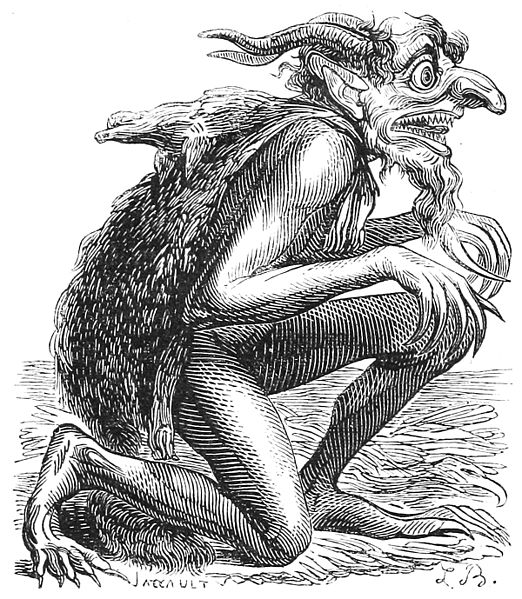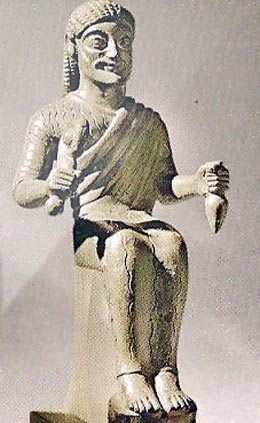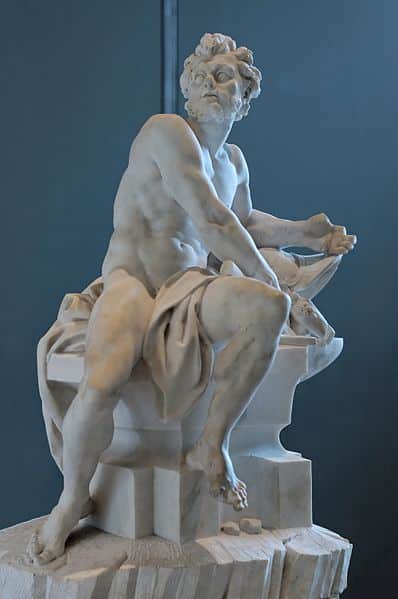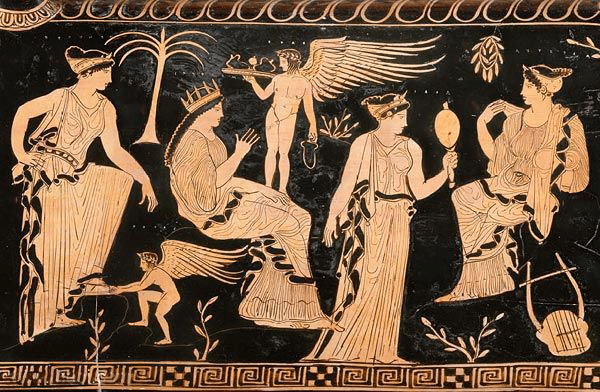In Greek mythology, Eurynome holds a modest yet intriguing position. This enigmatic Titaness, often overshadowed by the more flamboyant gods and goddesses, carries a tale intertwined with grace and ancient cosmic lore. Her narrative, though not as frequently recounted as those of Zeus or Hera, unveils a unique aspect of the ancient Greek understanding of the divine and the natural world. As one of the elder Oceanids, daughters of Oceanus and Tethys, and the third bride of Zeus, her story is woven with threads of both nurturing grace and the boundless waters of the earth.
The name Eurynome beckons a sense of mystery and elegance, much like the gentle ripples on a tranquil lake under the soft glow of moonlight. Her story, though not as tumultuous as some other divine beings, carries a subtle charm that invites a closer look into the lesser-explored corners of Greek mythology.
Eurynome Key Facts
| Keyword | Fact |
| Parents | Oceanus and Tethys (Elder Oceanid) |
| Partners | Zeus (Third Bride) |
| Siblings | Numerous, including Thetis and Metis |
| Offspring | The Three Graces (Charites), Antheia |
| Other names | – |
| Roman name | – |
| The Goddess of | Grace, Pastures, and Water-Meadows |
| Symbols | – |
Name and Etymology
The name Eurynome (pronounced yoo-RIN-oh-mee) carries with it a gentle cadence, reminiscent of a calm breeze over the meadows she’s believed to govern. The etymology of her name is rooted in ancient Greek, where “eurys” means wide and “nomos” signifies pasture or law, painting a picture of expansive meadows and the gentle rule she exerts over her domain.
In Roman mythology, there isn’t a direct counterpart to Eurynome, which further accentuates her unique position in Greek mythology. While many Greek deities have Roman equivalents with similar attributes and stories, Eurynome’s tale remains distinctly Hellenic. This absence in Roman lore perhaps speaks to the nuanced differences in how the two ancient civilizations perceived the divine and the natural world.
Her other epithets are scarce, further shrouding her in a veil of mystery. Unlike other deities who boast a myriad of titles reflecting their diverse roles and attributes, Eurynome’s identity remains closely tied to her primary domain of grace and meadows, a serene figure amidst the often tumultuous lives of her divine kin.

Eurynome Origins
Eurynome’s lineage hails from the ancient and primordial beings of Greek mythology. She is a daughter of Oceanus and Tethys, the Titan deities of the ocean and rivers, respectively. This lineage ties her closely to the natural world, embodying the gentle flow of water across the vast pastures she governs.
While there isn’t a rich tapestry of tales surrounding her birth or childhood, Eurynome’s narrative picks up a mystical hue with her role as a mother. She is often identified as the mother of the Three Graces (Charites) – Aglaea, Euphrosyne, and Thalia, who were born from her union with Zeus, the king of gods. These daughters personify charm, beauty, and creativity, attributes that seem to echo the serene and nurturing essence of Eurynome herself.
Her personification as a deity of meadows and grace brings a touch of the idyllic into the often dramatic and tumultuous narrative of Greek mythology. Eurynome, as a Daemone (Spirit), embodies a gentler aspect of the divine, a soft whisper amidst the roaring tales of heroism and wrath that often characterize the ancient Greek divine narrative.
Eurynome Lovers and Relationships
Eurynome’s romantic narrative is a brief yet significant one. Her union with Zeus, the formidable king of the gods, resulted in the birth of the Three Graces, who would go on to become beloved figures in Greek mythology.
Relationship with Zeus

The alliance between Eurynome and Zeus is not enveloped in the passionate drama that often characterizes divine relationships in Greek mythology. Instead, it carries a tone of gentle collaboration, a union of the sky and the meadows to birth grace and beauty into the world. The Three Graces, their offspring, embody the harmonious blend of their parents’ domains, bringing charm, joy, and creativity to both gods and mortals alike.
Their relationship also reflects a broader theme in Greek mythology, where the union of different aspects of nature and the divine result in the creation of new beings and concepts. Through their relationship, the narrative explores the idea of harmonious co-existence and the birth of beauty from such unions, a theme that resonates through many other tales within Greek mythology.
Eurynome Offspring
The offspring of Eurynome and Zeus, the Three Graces, are perhaps the most significant aspect of her narrative. Each daughter embodies a unique aspect of charm and grace, reflecting the serene and nurturing essence of their mother.
The Three Graces (Charites)
Aglaea, the eldest, embodies splendor and shines with the gentle glow of beauty. Euphrosyne represents mirth, her essence a soft ripple of joy spreading through the hearts of gods and mortals alike. Thalia, the youngest, personifies good cheer, her presence a soothing balm amidst the often harsh realities of the ancient Greek world.
Their narrative intertwines with many other divine tales, as they accompany other gods and goddesses, spreading their gentle charm wherever they go. Through them, Eurynome’s essence touches the lives of both divine and mortal beings, a soft whisper of grace amidst the roaring tide of ancient Greek mythology.
Depiction And Characteristics
Her appearance often mirrors the gentle essence of the meadows she governs. She is usually depicted as a beautiful woman, her form embodying the grace and elegance that she represents. The imagery often associated with her includes flowing water and vast pastures, reflecting her dominion over water-meadows and her lineage as a daughter of the Titans of the ocean and rivers.
The symbols associated with Eurynome are scarce, further accentuating the enigmatic aura that surrounds her. Unlike other deities whose attributes are often clearly defined by various symbols, Eurynome’s identity remains closely tied to the natural world she governs, a serene figure amidst the often tumultuous lives of her divine kin.
Eurynome Personality
The personality of Eurynome, as gleaned from the sparse tales surrounding her, reflects a calm and nurturing essence. Her demeanor contrasts with the often fiery and tumultuous personalities of other Greek deities. She embodies a gentle rule over her domain, a soft touch of grace amidst the often harsh and unforgiving world of Greek mythology.
Her actions within the myths reflect a deity content with her role, a nurturing figure who brings a touch of beauty and grace into the world through her offspring. The serene essence of Eurynome offers a gentle whisper of calm, a soothing balm amidst the roaring storms that often characterize the lives of her divine kin.
Eurynome In Ancient Greek Religion
Eurynome’s worship in ancient Greek religion is as enigmatic as her narrative. She was venerated at a sanctuary near the confluence of the rivers Neda and Lymax in classical Peloponnesus. This sanctuary, nestled amidst the natural beauty of flowing rivers, reflects Eurynome’s close association with water and nature.
Sanctuary Near Neda and Lymax
The sanctuary near the confluence of the rivers Neda and Lymax served as a sacred space for the worship of Eurynome. The serene setting of the sanctuary, with the gentle flow of rivers, mirrors the tranquil and nurturing essence of Eurynome. It’s a place where the ancient Greeks could connect with the gentle aspect of the divine embodied by Eurynome.
Mermaid Statue Representation
Eurynome was represented by a statue resembling what modern observers would identify as a mermaid. This representation further accentuates her connection to water and the gentle, nurturing essence she embodies. The mermaid statue, with its grace and elegance, serves as a visual embodiment of Eurynome’s serene dominion over water-meadows and grace.
Identification by Pausanias
The Greek traveler, Pausanias, identified Eurynome with the Oceanid, or “daughter of Ocean”, as reported in Greek poetry. This identification aligns with the narrative of Eurynome being one of the elder Oceanids, daughters of Oceanus and Tethys. Pausanias’ account provides a link between the worship of Eurynome and the poetic narrative of the Oceanids in Greek mythology.
The worship of Eurynome, though not as widespread or elaborate as that of other deities, carries a unique charm. Her sanctuary, the mermaid statue, and the identification by Pausanias, all contribute to the understanding of Eurynome’s place within ancient Greek religion. Through these elements, the gentle and nurturing essence of Eurynome is honored and revered, offering a glimpse into the softer aspects of the divine within Greek mythology.
Eurynome Roles And Responsibilities
Eurynome’s role within the divine narrative of Greek mythology is a subtle yet significant one. Her dominion over water-meadows and grace reflects a gentle aspect of the divine, a nurturing essence that contrasts with the often harsh and tumultuous lives of other deities.
Her primary responsibility lies in governing her domain with a gentle hand, ensuring the harmonious flow of nature’s grace across the meadows she oversees. This role, though not as dramatic as those of other deities, carries a unique charm, a soft whisper of the idyllic amidst the often stormy narrative of Greek mythology.
The birth of the Three Graces from her union with Zeus further extends her responsibilities into the realm of beauty, joy, and creativity. Through her offspring, Eurynome’s gentle essence touches the lives of both gods and mortals, spreading a soft glow of grace across the ancient Greek world.
Myths about Eurynome
The myths surrounding Eurynome are sparse yet intriguing. Her narrative intertwines with that of her offspring, the Three Graces, who play a significant role in various divine tales. Additionally, her role as a nurturing figure to Hephaestus, the blacksmith god, and her early reign over Olympus alongside Ophion, add layers of complexity to her character within Greek mythology.
Birth of The Three Graces
The birth of the Three Graces is perhaps the most significant myth associated with Eurynome. Her union with Zeus results in the creation of these three divine beings who embody beauty, joy, and creativity. This myth reflects a broader theme within Greek mythology, where the union of different aspects of nature and the divine result in the birth of new concepts and beings.
Nursing Hephaestus

In a tale of compassion and maternal care, Eurynome, alongside Thetis, comes to the aid of Hephaestus when he is cast out from Olympus by his mother, Hera, who was repelled by his crippled form. The two goddesses catch Hephaestus and nurse him on the banks of the earth-encircling river Oceanus. During his time in their care, Hephaestus resides in a cave by the ocean, forging exquisite artifacts for nine years. This narrative not only highlights Eurynome’s nurturing nature but also her connection to other significant figures within Greek mythology.
Marriage of Charis and Hephaestus
Further intertwining her narrative with that of Hephaestus, Eurynome’s daughter, Charis, one of the Three Graces, later becomes the bride of Hephaestus. This union symbolizes a harmonious blend of grace, beauty, and craftsmanship, further enriching the interconnected tales within Greek mythology.
Representations Of Eurynome In Art
The representations of Eurynome in ancient art are scarce, further shrouding her in a veil of mystery. Unlike other deities who are frequently depicted in various forms of art, Eurynome’s presence remains a subtle one. However, there are a few pieces of art that have captured the essence of this enigmatic Titaness, reflecting her serene essence and her connection to other divine beings.
Greek Eros Vase

One such representation is seen in a Greek vase depicting Eros, the god of love. The vase primarily focuses on Eros. However, the presence of Eurynome can be inferred through the depiction of the Three Graces. They are her daughters, and are often seen accompanying Eros in various mythological narratives. The vase serves as a visual narrative, intertwining the themes of love, beauty, and grace,. All themes which are emblematic of Eurynome’s gentle influence within Greek mythology.
Her depictions, when present, often mirror the serene essence she embodies. The imagery of flowing water and lush meadows serves as a backdrop to her graceful form, painting a picture of gentle dominion over her natural domain.
The sparse representations of Eurynome in art reflect her enigmatic position within Greek mythology. Her story is definitely as spectaular as that of some of the other deities. However, it carries a unique charm that invites a closer look into the lesser-explored corners of ancient Greek lore. Through these artistic portrayals, the gentle and nurturing essence of Eurynome is subtly brought to life. Furthermore offering a visual exploration into her divine narrative.
Mentions in Ancient Texts
Eurynome’s presence in ancient texts might not be as extensive as some other deities. However, it provides a glimpse into her role and significance within Greek mythology. Various authors have touched upon her narrative, each contributing to the understanding of this enigmatic Titaness.
Homer’s Account in “The Iliad”
Homer, the legendary ancient Greek poet traditionally said to have authored the epic poems “The Iliad” and “The Odyssey” around the 8th century BC, mentions Eurynome in “The Iliad”. In this epic, he recounts the tale of Hephaestus being cast out from Olympus by Hera and being rescued by Eurynome and Thetis. They nurse the fallen god by the banks of the river Oceanus.
“Thetis and Eurynome, the daughter of Oceanus, offered him refuge. He stayed with them for nine years in their cave at the edge of the ocean making splendiferous artifacts.”
This mention not only highlights Eurynome’s nurturing nature but also her connection to other significant figures within Greek mythology.
Hesiod’s Account in “Theogony”
Hesiod, another revered ancient Greek poet who lived around the same time as Homer, mentions Eurynome in his work “Theogony”, a poem describing the origins and genealogies of the Greek gods. In “Theogony”, Hesiod recounts Eurynome’s lineage as one of the daughters of Oceanus and Tethys, and her role as the mother of the Three Graces born from her union with Zeus.
“Eurynome bore the Graces to Zeus.”
Hesiod’s account provides a foundational understanding of Eurynome’s place within the divine lineage and her significant contribution to Greek mythology through the birth of the Three Graces.
Apollodorus’s Account in “The Library”
Apollodorus, an ancient Greek scholar and author who lived in the 2nd century BC, also mentions Eurynome in his work “The Library”, a comprehensive compilation of Greek myths and heroic legends. He affirms Eurynome’s identity as an Oceanid and the mother of the Three Graces in his narrative, aligning with the accounts of Homer and Hesiod.
“The Graces are the daughters of Zeus and Eurynome.”
Apollodorus’s account in “The Library” serves as a significant source of Greek mythology. It further cements Eurynome’s role and significance within the ancient Greek divine narrative.
Frequently Asked Questions
Eurynome is a daughter of Oceanus and Tethys, the ancient Titan deities of the ocean and rivers.
Eurynome is known as the mother of the Three Graces, who were born from her union with Zeus. She is also associated with water-meadows and grace.
The offspring of Eurynome are the Three Graces: Aglaea, Euphrosyne, and Thalia, who embody beauty, joy, and creativity.
Unlike many Greek deities, Eurynome does not have a direct Roman equivalent, making her a unique figure within Greek mythology.
Eurynome is often depicted as a beautiful woman amidst imagery of flowing water and lush meadows.
Eurynome’s powers lie in her dominion over water-meadows and grace, embodying the gentle nurturing essence of nature.
Featured Image Credit: H.-P.Haack, Public domain, via Wikimedia Commons
